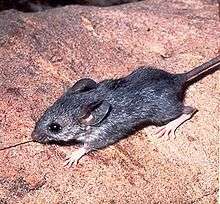Cactus mouse
| Cactus mouse | |
|---|---|
 | |
| Scientific classification | |
| Kingdom: | Animalia |
| Phylum: | Chordata |
| Class: | Mammalia |
| Order: | Rodentia |
| Family: | Cricetidae |
| Genus: | Peromyscus |
| Species group: | P. eremicus |
| Species: | P. eremicus |
| Binomial name | |
| Peromyscus eremicus (Baird, 1858) | |
 | |
| Cactus mouse range in North America | |
The cactus mouse (Peromyscus eremicus) is a species of rodents in the family Cricetidae. They are one species of a closely related group of common mice often called deer mice.[2] Cactus mice are small, between 18 and 40 g in weight. Females weigh slightly more than males and are significantly larger in body length, ear length, length of mandible and bullar width of skull. Cactus mice can be identified by having naked soles on their hind feet, and almost naked tails which are usually the same length or longer than the animals body length. Its ears are nearly hairless, large, and membranous. Their fur is long and soft; coloration varies between subspecies, as well as between different populations. Color of fur varies from ochre to cinnamon, with a white stomach, and the sides and top of head slightly grayish.[3] Females tend to be slightly paler in color than males, while juveniles appear more gray than their parents.
Distribution and diet
Cactus mice are found in dry desert habitats in southwestern United States and northern Mexico, as well as islands off the coast of the Baja California peninsula and in the Gulf of Mexico.[4][5] Low average temperatures and lack of mesquite (Prosopis juliflora) might limit northern expansion.[3] The cactus mouse occurs sympatrically with four other mice species, including the California mouse, canyon mouse, Eva's desert mouse and the mesquite mouse. The cactus mouse is nocturnal and feeds on seeds, mesquite beans, hackberry nutlets, insects, and green vegetation.[3] Species from Southern California have tested positive for hantavirus.[6]
References
- ↑ Linzey, A.V., Timm, R., Álvarez-Castañeda, S.T., Castro-Arellano, I. & Lacher, T. (2008). Peromyscus eremicus. In: IUCN 2008. IUCN Red List of Threatened Species. Retrieved 3 September 2009. Database entry includes a brief justification of why this species is of least concern.
- ↑ National Park Service Website
- 1 2 3 Veal, Rita; Caire, William (1979). "Peromyscus eremicus" (PDF). Mammalian Species (American Society of Mammalogists) (118): 1–6. doi:10.2307/3503858.
- ↑ Brand, Leonard R.; Ryckman, Raymond E. (1968). "Laboratory Life Histories of Peromyscus eremicus and Peromyscus interparietalis". Journal of Mammalogy 49 (3): 495–501. doi:10.2307/1378208.
- ↑ Superfamily Muroidea. Pp. 894–1531 in Mammal Species of the World a Taxonomic and Geographic Reference. D. E. Wilson and D. M. Reeder eds. Johns Hopkins University Press, Baltimore.
- ↑ Journalof the Society Of Vector Ecologists, Volume 26, Issue 2, December 2001
